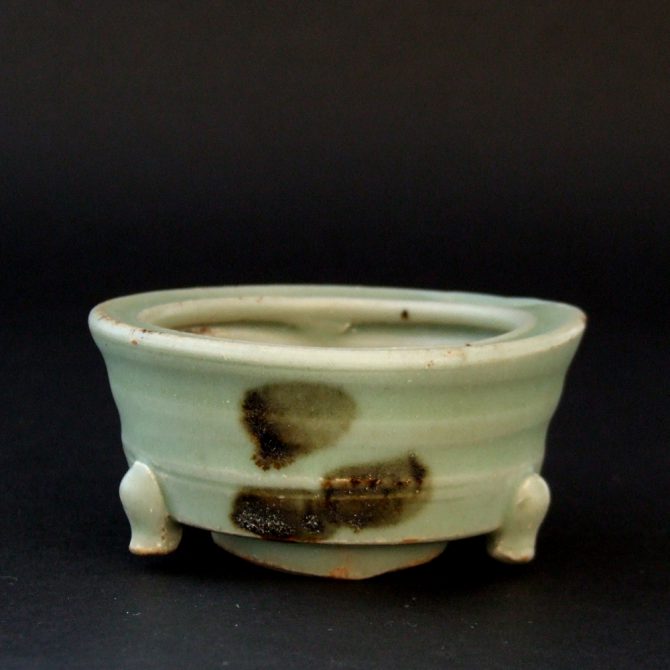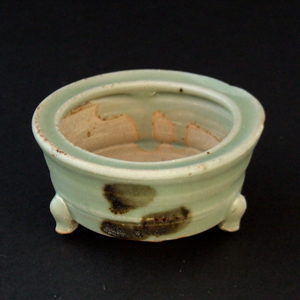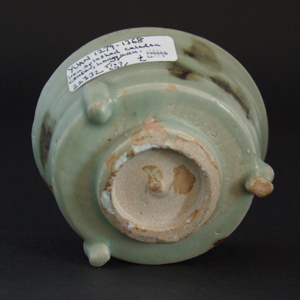
YUAN 1279 – 1368 Longquan Celadon Ware
A Small Celadon Ware Censer, Yuan Dynasty 1279-1368. Probably from Longquan Kilns, Zhejiang Province. The Circular Form with Channels and Ridges in Imitation of Bamboo. There are Three Small Cabriole Style Legs, However the Censer is Supported by it`s Footrim. The Sides Painted with Large Iron-spots Using a Wet Brush. Probably Recovered from a Shipwreck.
SOLD
- Condition
- The glaze is semi-matt, probably due to immersion in sea water. A very small but quite deep chip to the rim, this appears to be polished c.8 mm including the polished area. A small firing crack to the outside wall of the censer.
- Size
- Diameter : 8 cm (3 1/4 inches)
- Provenance
- N/A
- Stock number
- 22332
Information
Celadon Ware :
Celadon is a term used to describe several types of Chinese stoneware and porcelain, as well a ceramics from other countries, notably from Korea and Japan. The term is a imprecise one, applying to various types of green glazed ceramics, but not all ceramics with green glazes, there are several wares that have a green glaze that are not refereed to as celadon. For example Green Jun and Ge Ware. For this reason there has been a move to try to clarify the situation by using the term `Green Ware`. But for now Celadon is a more familiar and therefore useful term. The origins of the term Celadon are not clear, one theory is that the term first appeared in France in the 17th century and that it is named after the shepherd Celadon in Honoré d`Urfé`s French pastoral romance, L`Astrée (1627), who wore pale green ribbons. (D`Urfe, in turn, borrowed his character from Ovid`s Metamorphoses.) Another theory is that the term is a corruption of the name of Saladin, the Ayyubid Sultan, who in 1171 sent forty pieces of the ceramic to Nur ad-Din, Sultan of Syria. Yet a third theory is that the word derives from the Sanskrit sila and dhara, which mean "stone" and "green" respectively. Celadon ware originated in Zhejiang Province in the Eastern Han Dynasty, however green monochrome glazes can be found on stoneware much before that date. Zhejiang is were the famous Longquan Celadons were made but Celadon wares were also produced at Jiangsu, Hubei, Hunan and Jiangxi. The production of Celadon Ware required a reducing atmosphere of around 1300 degrees C., the colouring agent was a mixture of iron oxide and titanium. The glaze was applied very thickly, and was full of tiny bubbles which defuse the light giving the appearance of richness and softness.
Censers :
Chinese censers have a long history, they are thought to have originated in the Eastern Zhou dynasty (770 - 256 B.C.). They are normally association with paying reverence to ancestors, the smoke omitted was thought to be a way for the living to communicate with the spirit of the dead. However, from early times there have been different censers for different functions including fumigation and even pest control. They also occur in many different forms. During the Western Han dynasty Western Han (206 B.C. - A.D. 8) the Boshan Xianglu universal mountain censer was developed. These bronze censors had elaborate craggy mountain peaked covers which aloud the incense smoke to waft out of naturalistically rendered holes, like so many bronze forms they were copied by potters who made lead-glazed pottery versions. The incense cones that created this smoke were made from plants, including magnolia, grasses and lovage, however early Taoists might have preferred something stronger, adapted censers for the religious and spiritual use of cannabis. Yuan, Ming and Qing dynasty ladies at court used novelty censers to fumigate new cloths, a Yuan poem includes the lines "The incense continues burning in the golden duck censor `til midnight, as court ladies keep trying on their new garments of silk and muslin". For a Ming dynasty bird form celadon censer see sold items stock number 18026. Most Chinese censer are, however, of circular form and sit on three low feet, the interior is unglazed and left in a biscuit state. Some of the Yuan and Ming celadon censers have impressed decoration to this biscuit area. Sand was placed inside the censer and josticks or cones were used. Many family`s had an alter at home where rituals were performed and respect was paid to their ancestors, incense burners were an important object in this context, often forming part of an alter garniature with a pair of vases. Indeed we know from the inscription on the famous `David Temple` vases now at the British Museum, not only that they were made in the year 1351, but that there was originally a censer with them, unfortunately now lost, (for an illustration of these important Yuan vases see our `Links` section, where they are shown next to the link to the British Museum website where you can read more about them). Because of there ritual use, censers, like the missing David censer, were sometimes commissioned for a specific temple or other building. They person commissioning them sometimes had a dedicatory inscription added. For example the Dehua blue and white censer, stock number 19766 (see `Sold` items). This has an inscription that mentions the name of the family who presented it, as well as the temple the piece was given to, along with a date, the twelfth year of Qianlong (1736 - 1795) equivalent to 1748. It also asks for more children and riches. China`s renewed connection with its spiritual past has meant that censers are once again being lit across the land.

